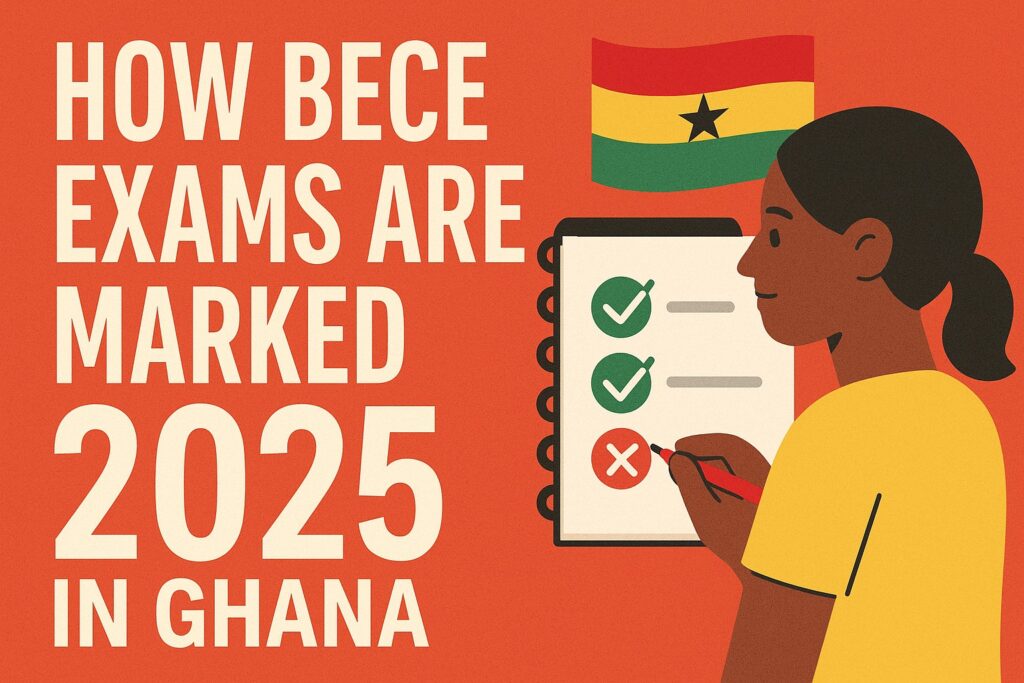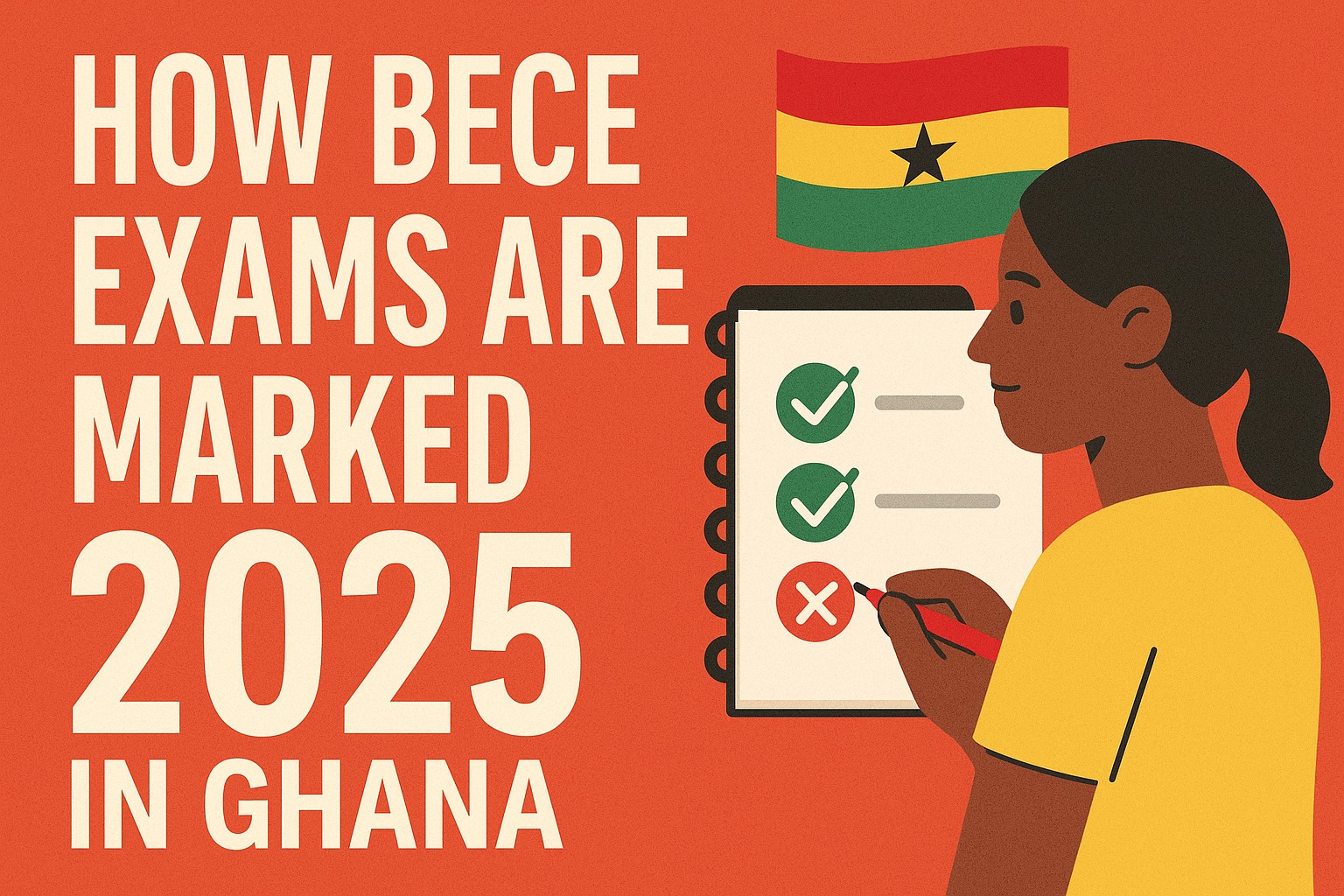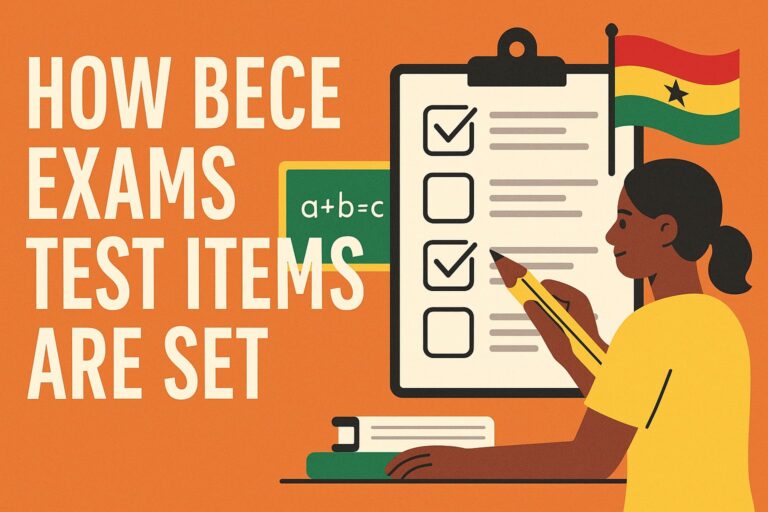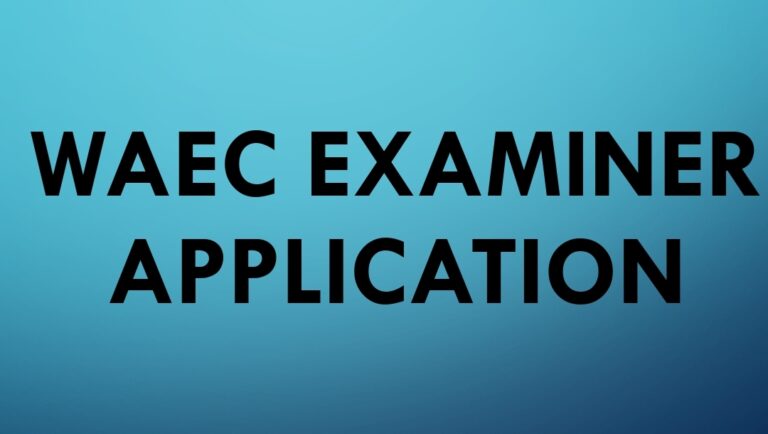Introduction
Hi there, and welcome! If you’re a student preparing for the BECE, a teacher guiding your learners, or a parent hoping to understand the system better, then you’re in the right place.
The Basic Education Certificate Examination (BECE) is one of the most important milestones in a Ghanaian student’s academic journey. It determines whether a student gains admission into senior high school—and ultimately, it shapes their future path. That’s why so much pressure is placed on doing well in this exam.
Over the years, I’ve had the opportunity to work behind the scenes as a WAEC examiner, especially for Mathematics. I’ve marked both BECE and WASSCE scripts and have been part of the processes many students never get to see. So today, I want to give you a clear, honest, and detailed breakdown of how BECE exams are marked—step by step, emphasizing the importance of understanding how BECE exams are marked to demystify the evaluation process.
There’s more to it than red pens and numbers. So, let’s dive in!
Understanding how BECE exams are marked is crucial for students aiming for success.
Understanding the Role of the Marking Scheme
Let’s start with something most students don’t even think about: the marking scheme. You might think examiners just sit down, read your answer, and decide whether it’s good or not—but it’s way more structured than that.
When the exam questions are being set, a draft marking scheme is created alongside the test items. This draft helps guide the setting process by ensuring that each question is markable and that answers can be evaluated fairly.
Once the questions are finalized, the subject masters—who are senior examiners and subject experts—meet at WAEC headquarters to agree on a final version of the marking scheme. This is a crucial part of the process.
RELATED ARTICLE
- How To Become WAEC Examiner To Mark WASSCE and BECE in Ghana
- How To Make 8As in WASSCE With Ease
- Upgrading WASSCE Results, Separating Facts from Fictions
The finalized marking scheme includes:
- Suggested answers: These are the model answers that are expected from candidates.
- Marks allocation: Every question has marks assigned to each part of the answer. For example, a 6-mark question may be broken down into 2 marks for the method, 3 for accuracy, and 1 for a final explanation.
- Alternative answers: In some subjects, especially like Mathematics and Science, there may be more than one correct method or explanation. These alternatives are carefully listed so that no candidate is penalized unfairly.
- Rubrics: For questions that require personal interpretation or open-ended responses—like English essays or practical tasks—a rubric is used. This helps examiners award marks based on structure, grammar, creativity, and adherence to instructions.
- Error penalties: The scheme also outlines which kinds of errors should result in mark deductions, whether it’s a wrong formula in Maths or missing a key point in Social Studies.
This marking scheme becomes our guide—it’s like our Bible during the marking process. And let me tell you, examiners don’t just “guess” what to award. Every mark must be justified and consistent, because our own work as examiners is also cross-checked.

How Marks Are Awarded in BECE
Now that we understand how the marking scheme works, let’s talk about how actual marks are awarded—especially in theory-based subjects like Mathematics, which happens to be my area of expertise.
When I first started marking, I was fascinated by how structured the process really is. In Mathematics, and many other subjects, there are generally three main types of marks that we award: M-mark (Method), A-mark (Accuracy), and B-mark (Blend or Balance). Let me break these down for you:
M-Mark (Method)
The M-mark stands for method. This is one of the most important parts of your answer, especially in Maths. It rewards your ability to use the correct approach or formula, even if you make a small calculation mistake later.
For example, if a question asks you to find the area of a circle and you write the correct formula (A = πr²), you might get the method mark—even if your final number is off because you used the wrong value for π or squared the radius incorrectly.
But here’s the catch: if you start with a completely wrong method, you lose both the M-mark and any A-mark that depends on it. That’s why showing your work clearly is so important.
From my experience, a lot of students lose easy marks because they skip steps or jump straight to the final answer without showing how they got there. Don’t do that—your method could earn you valuable marks even if you mess up the arithmetic.
A-Mark (Accuracy)
Then we have the A-mark, which is given when you get the correct final answer. But here’s the thing: in most cases, the A-mark depends on you first getting the M-mark. So if your method is wrong, your final answer is automatically assumed to be incorrect—even if you somehow guessed the right number.
There are a few rare exceptions, though. Sometimes, based on the examiner’s discretion, a correct final answer might still get credit even if the method isn’t perfect—but that’s not something to rely on. The best way to secure both the M and A marks is to work through each step carefully and logically.
B-Mark (Blend/Balance)
Finally, we have the B-mark, which is used when it’s hard to distinguish between method and accuracy. These are common in practical-based or visual questions, such as drawing a graph, labeling a diagram, or doing a geometric construction.
In these cases, marks are awarded based on overall effort and presentation, not just method or answer. For instance, if a student draws a fairly accurate pie chart with clear labeling and correct angles, they might earn a B-mark even if a minor error is present.
In all of this, what matters most is clarity, logical flow, and neatness. Trust me—when you’re marking hundreds of scripts in a row, a well-organized answer stands out!
Pre-Marking Preparation (From the Examiner’s Lens)
Now let me take you behind the scenes—because before we even touch a student’s script, there’s a whole lot of preparation that goes on.
Usually, about two weeks before the marking officially begins, examiners receive a notification letter or call from WAEC. This informs us of our selection and provides details about where the marking will take place.
The marking venues are often set in high schools or teacher training colleges across the country. We call it “Conference Marking.” When we arrive at the venue, the first day typically starts with a general briefing session. All subject examiners—Maths, English, Science, Social Studies, etc.—gather in a large hall for this opening meeting.
During this briefing, WAEC officials talk to us about:
- This year’s marking policies
- Payment rates for scripts marked
- Important cautions about fairness and neutrality
- Instructions about conduct and time management
After this, we’re split into subject-specific groups. As a Mathematics examiner, I always join the other Maths teachers and we’re assigned to a room with a team leader who oversees our work.
We don’t jump straight into real student scripts yet. Instead, we’re given dummy scripts—these are mock papers created by WAEC that represent common answers students might write. We use these to practice marking and get used to the year’s marking scheme.
This stage is vital. It’s where we debate questions like:
- “What if a student uses an alternative method here?”
- “Should we accept this version of the answer?”
- “How many marks should be deducted for this error?”
These conversations help ensure uniformity and consistency so that every student is judged by the same standards, no matter who marks their scripts.
The Conference Marking Process
Once the practice sessions using dummy scripts are done, we officially enter the Conference Marking phase, and this is where things really begin to get intense.
In our subject-specific rooms—mine is usually Mathematics—we sit around tables with our dummy scripts, and we go over realistic student responses to questions using the finalized marking scheme provided by WAEC.
Each script is dissected. One examiner might ask,
“This student used an unconventional method but arrived at the correct answer. Should that be accepted?”
And then the team leader, who acts as the subject coordinator, will guide us based on the scheme and his or her years of experience. These discussions are incredibly important because they help us build a shared understanding of how flexible—or strict—we need to be for each type of question.
Sometimes, scenarios are demonstrated right on the board or with sample answers, especially for complicated questions that are likely to trip up many students. For instance, a student might mislabel their axes in a graph question—does that mean they should lose all their marks, or just the A-mark?
Our team leader will usually say,
“Let’s be firm but fair. Penalize if the mislabeling affects interpretation. If not, award partial marks.”
This is where marking becomes part science and part art. You must balance consistency with empathy, always keeping in mind that behind each script is a real student who spent months preparing for the BECE.
And trust me, as an examiner, you feel that weight.
We also go through timing guidelines—how many scripts we’re expected to mark in a day without compromising quality—and we’re advised to avoid burnout, because tired eyes and a weary brain can lead to unfair marking. That’s why we often work in shifts with breaks in between.
By the end of the Conference Marking phase, everyone in the room is on the same page—literally and figuratively. We’ve rehearsed, debated, agreed, and understood the marking principles for each question. Only then are we given access to live scripts for the real marking process.
The Actual Marking Process
Now comes the real deal—marking actual scripts written by BECE candidates across the country.
Each examiner is assigned a batch of scripts. We sit down, open the first page, and begin the careful, methodical process of marking using the scheme we’ve internalized during Conference.
Let me be honest—this part can be mentally draining. But it’s also the most rewarding, because we finally get to see how students responded to the questions we’ve been studying.
For each answer, I ask myself:
- Did the student understand the question?
- Did they apply the right method?
- Is the final answer correct?
- Are their workings clear and logical?
- Have they made any critical omissions or errors?
After marking a batch, I don’t just throw them into a box and move on. No. Every batch I finish goes straight to my Team Leader for vetting.
The team leader picks scripts randomly and cross-checks my marking. If I’ve awarded a wrong mark, overlooked something, or been inconsistent with the scheme, they point it out immediately. It keeps us all on our toes and ensures fairness is maintained.
Once the scripts are vetted and approved, they are handed over to WAEC officials stationed at the marking venue. At this point, we also enter the marks into special mark sheets or digital forms, depending on the system used that year.
And it doesn’t stop there.
After all the scripts are submitted and marked, WAEC assigns a team of “Checkers.” These individuals are hired just to verify the total marks added for each candidate. If there’s a mistake in the summation, they fix it—either by increasing or decreasing the total score.
The final scores are then uploaded to WAEC’s database and sent to the headquarters for official results processing and publication.
That’s how thorough it is.
When I first joined the marking process years ago, I didn’t realize how many layers of quality control there were. But after seeing it firsthand, I gained even more respect for the system. It’s not perfect, but it’s designed to be as fair, balanced, and professional as possible.
Quality Checks and Finalization
By the time we reach this stage, most of us examiners feel like we’ve run a marathon—but the process doesn’t end with the last mark awarded on the paper.
WAEC has set up an entire quality control system to ensure no student is shortchanged or wrongly scored. After all, the stakes are high—this exam can determine a student’s admission into senior high school.
One of the first layers of this quality assurance process involves what we call Checkers.
These are people specifically trained and hired just to recalculate the total marks on each script. As strange as it may sound, it’s easy to make summation errors after marking dozens of scripts in a day. That’s why Checkers play such an important role—they go through the marked scripts to ensure the final total score is accurate and free from addition mistakes.
I remember one year, a script I marked was flagged by a Checker. I had miscalculated the total by two marks—honest mistake—but imagine if that student missed their preferred school because of it? That’s when it hit me how crucial every detail is in this process.
Once the Checkers are done, the results are entered into WAEC’s internal system, and each candidate’s scores across all subjects are matched with their candidate number. From there, everything is forwarded to the WAEC headquarters, where the final stages of result processing and classification happen.
That’s also when statistics, performance analyses, and national summaries are created—things we see later on in news headlines like “73% of students passed Mathematics” or “Girls outperformed boys in English.”
But to get to that point, it takes days of concentrated effort, precision, and integrity.
Why This Process Matters for Students
Now, let me speak directly to you—the student (or the concerned parent reading this). After being part of the marking process for years, I can confidently tell you: WAEC does not take this lightly.
Everything I’ve shared so far—from the conference training, to team vetting, to Checkers double-checking every score—is done to ensure one thing: fairness.
No one is sitting behind the scenes randomly giving out marks or deliberately failing students. Every single mark on your paper is earned, discussed, and verified. That’s why your performance on the exam—how well you follow instructions, show your method, and present your answers clearly—matters so much.
Here’s what I’ve observed over the years:
- Students who show their working in Mathematics usually earn method marks, even if their final answer is wrong.
- Those who write legibly and organize their thoughts clearly tend to receive better feedback, especially in English essays and comprehension.
- Students who follow instructions strictly are more likely to avoid penalties.
So if you’re preparing for the BECE, I want you to study with confidence—not fear. Know that if you put in the effort, it will show on paper. And if it shows on paper, there’s a whole team of trained professionals (including me) who will make sure it counts.
To me, understanding how marking works should not make you anxious. Instead, it should guide how you prepare.
Focus on:
- Mastering your concepts (especially in subjects like Math and Science)
- Practicing how to explain your thoughts clearly
- Following the exact requirements of each question
- Paying attention to neatness and time management
Remember, the examiner is not your enemy—we’re rooting for you. I’ve personally smiled while marking some impressive scripts, thinking, “This student really got it!” And I’ve felt concern for others who clearly rushed through.
But at the end of the day, every script gets the attention and fairness it deserves.
Conclusion
Looking back over the years I’ve spent marking BECE and WASSCE scripts, I can honestly say the process is both intense and deeply rewarding. It’s not just about marking correct or wrong answers—it’s about acknowledging a student’s effort, their thought process, and how well they followed the instructions given.
Marking is more than red pens and ticks. It’s a carefully structured system that respects fairness, precision, and student potential. I’ve worked with examiners who pour their hearts into it, ensuring every candidate gets what they deserve—no more, no less.
My biggest takeaway?
If you’re a student preparing for BECE, understand that success isn’t just about knowing the answer. It’s about:
- Showing your method clearly.
- Following instructions exactly.
- Staying calm and organized during the exam.
When you approach your papers with clarity and confidence, it shows—and we, as examiners, can see it.
So as you prepare, don’t let anxiety cloud your efforts. Instead, let this behind-the-scenes look empower you. Trust the system, trust your hard work, and remember that your performance will speak for you when you can’t be there to explain yourself.
Frequently Asked Questions (FAQs)
Q1: Can examiners favor certain schools or candidates?
Absolutely not. Scripts are anonymized—we don’t see names, schools, or anything that reveals a candidate’s identity. Everything is tied to a code, so bias is removed completely from the process.
Q2: Is handwriting important during marking?
Yes, it is. While neatness isn’t awarded extra marks, illegible handwriting can cost you. If we can’t read what you’ve written, we can’t mark it—even if it’s correct.
Q3: What happens if a script is marked incorrectly?
That’s where the Team Leaders and Checkers come in. Every script goes through at least two sets of eyes. If mistakes slip through, they’re caught and corrected before results are finalized.
Q4: Do spelling and grammar mistakes matter in non-English subjects?
Usually not, unless the mistake changes the meaning of your answer. But in English Language papers, grammar, spelling, and sentence structure are part of the assessment, especially in essays.
Want more insider tips on BECE preparation straight from someone who’s been in the examiner’s seat?
- Subscribe to my newsletter where I share weekly exam tips, past question breakdowns, and motivational advice for students.
- Follow me for updates and live Q&A sessions.
- Drop your questions in the comments—I love hearing from you!
Your success is possible. Your effort counts. Let’s prepare smart, not just hard.







One Comment
Comments are closed.